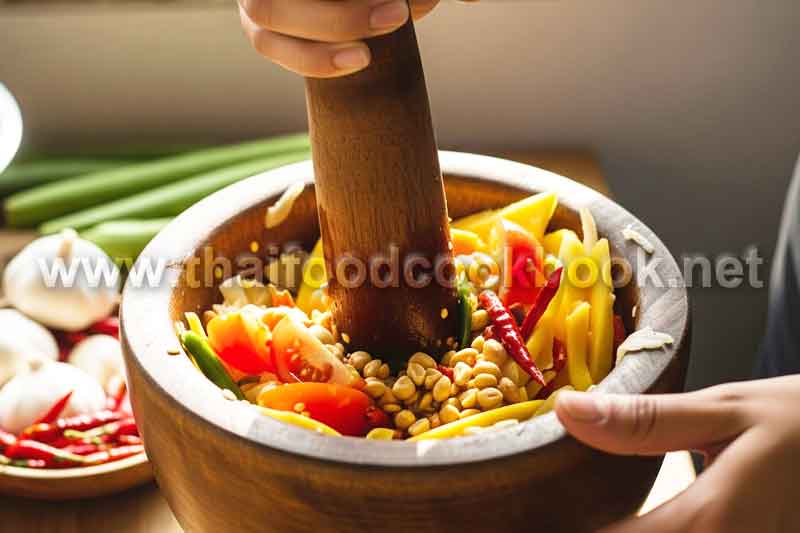Som Tum’s Cultural Significance in Isan & Beyond
While Som Tum is often celebrated as one of Thailand’s most beloved street foods, many people don’t realize just how deep its roots go—especially in the northeastern region known as Isan. In both rural and urban communities, this spicy green papaya salad is far more than just a meal; it represents identity, connection, and memory. Yet, modern diners often miss its cultural depth, focusing only on flavor or presentation. Understanding Som Tum’s cultural role can unlock an entirely new appreciation for Thai cuisine. Whether you’re exploring the heritage of Thai food or planning to prepare it yourself, this journey through Som Tum’s cultural significance offers insights that go far beyond ingredients.
Isan Origins: The Birthplace of Som Tum Tradition
Isan, the northeastern region of Thailand bordering Laos, is the cradle of Som Tum’s most authentic forms. Known for its arid landscapes and deeply communal society, Isan cuisine evolved around bold flavors, preserved ingredients, and sharing meals under open skies. Som Tum, or “Tam Mak Hoong” as it’s known in the Lao dialect, originated here as a humble, home-prepared dish.
Key cultural aspects of Som Tum in Isan include:
- Gathering food locally: Green papaya, chilies, and fermented fish sauce (Pla Ra) are often homegrown or homemade.
- Communal preparation: Making Som Tum is often a social act — people gather to pound and taste together.
- Ritual significance: The dish is featured in festivals, temple offerings, and family ceremonies.
In this context, Som Tum is more than nourishment—it’s an expression of survival, creativity, and belonging.
Som Tum as a Symbol of Identity for Isan People
For millions of Isan natives living in Bangkok and abroad, Som Tum serves as a powerful connection to home. The familiar scent of roasted chilies and Pla Ra immediately evokes memories of village life, family dinners, and cultural pride.
Why Som Tum Matters in Isan Identity:
- Cultural continuity: It helps Isan people maintain linguistic and culinary traditions across generations.
- Affordable heritage food: It remains accessible to people of all income levels, reinforcing class inclusivity.
- Emotional comfort: The dish provides emotional support to migrants facing isolation in cities.
Som Tum stalls across Bangkok and international Thai communities become cultural meeting points where the Isan diaspora can reconnect and maintain tradition amidst change.
Modern Interpretations & Global Spread of Som Tum
As Thai cuisine has gained international popularity, Som Tum has seen countless reinterpretations in urban cafes, cooking shows, and social media. Yet, even in its modern form, the dish often carries the essence of its Isan roots—especially when made with attention to balance, spice, and cultural context.
Modern Trends in Som Tum Culture:
- Fusion recipes: Variants now include ingredients like avocado, smoked salmon, or quinoa.
- Instagrammable plating: Street food has turned chic, making Som Tum a featured item in trendy eateries.
- Health-forward adaptations: Vegan and gluten-free Som Tum recipes are common among wellness communities.
Even in its evolution, the core essence of Som Tum—freshness, intensity, and sharing—remains intact. Its cultural meaning is not lost but rather adapted, reflecting the dynamic nature of food heritage.
Som Tum in Ceremonies, Gatherings & Spiritual Life
In Isan and many Thai communities, food is spiritual. Som Tum plays a central role in merit-making, weddings, and annual festivals like Songkran. It’s often prepared in large batches and shared with neighbors, monks, and family members.
Key Roles in Cultural and Religious Settings:
- Temple offerings: Symbolizes respect for ancestors and deities.
- Weddings and funerals: Represents the circle of life and unity among attendees.
- Harvest celebrations: Honors the earth and community bonds.
Its place in these events shows how deeply interwoven Som Tum is with Thai values: generosity, respect, and harmony. As noted in global culinary publications, this salad is as sacred as it is delicious.
Conclusion: Som Tum as Culinary Heritage and Cultural Bridge
Som Tum is not just a dish. It’s a vessel of memory, a bridge between generations, and a cultural emblem of the Thai people—especially in Isan. From pounding papaya in clay mortars to gathering around plastic stools in city markets, the dish tells stories of family, identity, migration, and resilience. As it continues to evolve and cross borders, its cultural weight remains unshaken. By understanding its roots and honoring its variations, we don’t just eat Som Tum—we participate in something sacred and enduring.
